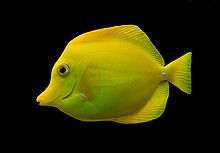Yellow tang
| Yellow tang | |
|---|---|
 | |
| Scientific classification | |
| Kingdom: | Animalia |
| Phylum: | Chordata |
| Class: | Actinopterygii |
| Order: | Perciformes |
| Family: | Acanthuridae |
| Genus: | Zebrasoma |
| Species: | Z. flavescens |
| Binomial name | |
| Zebrasoma flavescens (E. T. Bennett, 1828) | |
| Synonyms | |
|
Zebrasoma rhombeum Bishop | |
The yellow tang (Zebrasoma flavescens) is a saltwater fish species of the family Acanthuridae. It is one of the most popular aquarium fish.
Taxonomy
The yellow tang was first described by English naturalist Edward Turner Bennett as Acanthurus flavescens in 1828 from a collection in the Hawaiian Islands. Its species name is the Latin adjective flavescens "yellow".
Yellow tang are in the surgeonfish family.
Description
Adult fish can grow to 20 centimetres (7.9 in) in length, and 1–2 centimetres (0.39–0.79 in) in thickness. Adult males tend to be larger than females. Yellow tang are bright yellow in color. At night, the yellow coloring fades slightly, and a prominent brownish patch develops in the middle with a horizontal white band. They rapidly resume their bright yellow color during daylight.
Food
In the wild, yellow tang feed on benthic turf algae and other marine plant material. In captivity they are commonly fed meat/fish based aquarium food, but the long term health effects of this diet are questionable. However, most experts in the marine aquarium industry express little skepticism that such a well rounded and balanced diet including plant and animal material would be in any way detrimental to mostly herbivorous fishes like tangs, since they still need on occasion, complex amino acids and nutrients that only ocean animals can provide. In the wild, yellow tang provide cleaner services to marine turtles, by removing algal growth from their shells.
Distribution and habitat

It is commonly found in shallow reefs, from 2–46 metres (6.6–150.9 ft) deep, in the Pacific Ocean, west of Hawaii and east of Japan. Hawaii is the most common place for aquarium harvesting, where up to 70% of the yellow tangs for the aquarium industry are sourced from.
The yellow tang has been recorded in waters around Florida, where it is not native.[1]
In the aquarium
The yellow tang is very commonly kept as a saltwater aquarium fish. In 2015, researchers successfully bred them in captivity.[2] They can grow up to 8 inches (20 cm) in the wild, but are introduced to aquariums in the 2" to 4" range. Some specimens as large as 6" are occasionally available. Life expectancy in the wild can exceed 30 years.[3]
References
- ↑ Schofield, Pamela J.; Morris Jr., James A. (28 January 2015). Field Guide to the Nonindigenous Marine Fishes of Florida. Maroon Ebooks. pp. 6–.
- ↑ "Yellow tangs finally captive bred by the Oceanic Institute Captive bred, Hawaii, News, Places, Saltwater Fish, Surgeonfish, United States, yellow tang Reef Builders". Reef Builders | The Reef and Marine Aquarium Blog. 2015-10-20. Retrieved 2017-08-05.
- ↑ Claisse, J., McTee, S., & Parrish, J. (2008). Effects of age, size, and density on natural survival for an important coral reef fishery species, yellow tang, Zebrasoma flavescens. Coral Reefs, 28, 95-105.
| Wikimedia Commons has media related to Zebrasoma flavescens. |
| Wikispecies has information related to Zebrasoma flavescens |
